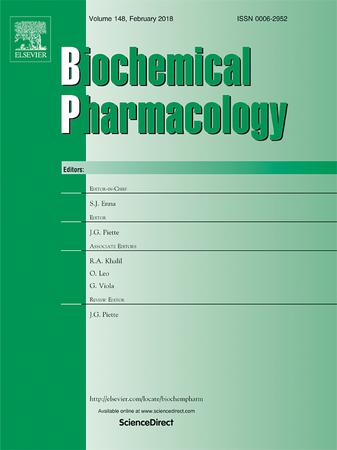Oridonin联合顺铂通过激活NOXA-BCL2轴协同诱导食管鳞癌细胞凋亡
IF 5.3
2区 医学
Q1 PHARMACOLOGY & PHARMACY
引用次数: 0
摘要
食管癌是一种起源于食管上皮细胞的恶性肿瘤,在中国约90%的病例中主要表现为食管鳞状细胞癌(ESCC)。以顺铂为基础的化疗方案仍然是ESCC的一线治疗选择,然而,患者的5年总生存率低得令人失望。冬凌草甲素是一种从中药冬凌草中提取的生物活性二萜,具有抑制多种恶性肿瘤的作用。目前,关于oridonin联合顺铂治疗ESCC的研究还比较有限。本研究旨在阐明oriidonin联合顺铂对ESCC的潜在协同抗癌作用,以及潜在的协同分子机制。体外实验显示,甲草甲素与顺铂联合使用可协同抑制ESCC细胞的增殖、迁移、侵袭。协同效应还通过增强NOXA转录活性和激活NOXA- bcl2轴,通过线粒体途径诱导细胞周期阻滞和促进细胞凋亡。体内实验证实了这些发现,显示联合治疗的小鼠皮下异种移植物肿瘤的生长明显减少,而没有加剧顺铂相关的副作用,如体重减轻或肝和肾毒性。综上所述,oriidonin与顺铂联用可通过激活NOXA-BCL2轴信号通路协同抑制ESCC的发展。该方法安全有效,在ESCC的综合治疗中具有广阔的应用前景。本文章由计算机程序翻译,如有差异,请以英文原文为准。

Oridonin combined with cisplatin synergistically induces apoptosis by activating the NOXA-BCL2 axis in esophageal squamous cell carcinoma
Esophageal cancer, a malignant neoplasm originating from the epithelial cells of the esophagus, predominantly manifests as esophageal squamous cell carcinoma (ESCC) in approximately 90% of cases in China. Cisplatin-based chemotherapy regimens remain the first-line therapeutic option for ESCC, however, the five-year overall survival rate of patients is disappointingly low. Oridonin, a bioactive diterpenoid extracted from the traditional Chinese medicine herb Donglingcao, has demonstrated inhibitory effects against various malignancies. Currently, research on the combination of oridonin and cisplatin for the treatment of ESCC is limited. This study aims to elucidate the potential synergistic anti-cancer effects of oridonin in combination with cisplatin on ESCC, along with the underlying synergistic molecular mechanisms. In vitro experiments revealed that the combination of oridonin and cisplatin could synergistically inhibit ESCC cell proliferation, migration, invasion. The synergistic effect also induced cell cycle arrest and promoted apoptosis via the mitochondrial pathway by augmenting NOXA transcriptional activity and activating the NOXA-BCL2 axis. In vivo experiments corroborated these findings, showing a marked reduction in the growth of subcutaneous xenograft tumors in mice treated with the combination, without exacerbating the cisplatin-associated side effects such as weight loss or hepatic and renal toxicity. In conclusion, the combination of oridonin and cisplatin can synergistically inhibit the development of ESCC through the activation of the NOXA-BCL2 axis signaling pathway. This treatment is both safe and effective, presenting a promising prospect for combined therapeutic application in ESCC management.
求助全文
通过发布文献求助,成功后即可免费获取论文全文。
去求助
来源期刊

Biochemical pharmacology
医学-药学
CiteScore
10.30
自引率
1.70%
发文量
420
审稿时长
17 days
期刊介绍:
Biochemical Pharmacology publishes original research findings, Commentaries and review articles related to the elucidation of cellular and tissue function(s) at the biochemical and molecular levels, the modification of cellular phenotype(s) by genetic, transcriptional/translational or drug/compound-induced modifications, as well as the pharmacodynamics and pharmacokinetics of xenobiotics and drugs, the latter including both small molecules and biologics.
The journal''s target audience includes scientists engaged in the identification and study of the mechanisms of action of xenobiotics, biologics and drugs and in the drug discovery and development process.
All areas of cellular biology and cellular, tissue/organ and whole animal pharmacology fall within the scope of the journal. Drug classes covered include anti-infectives, anti-inflammatory agents, chemotherapeutics, cardiovascular, endocrinological, immunological, metabolic, neurological and psychiatric drugs, as well as research on drug metabolism and kinetics. While medicinal chemistry is a topic of complimentary interest, manuscripts in this area must contain sufficient biological data to characterize pharmacologically the compounds reported. Submissions describing work focused predominately on chemical synthesis and molecular modeling will not be considered for review.
While particular emphasis is placed on reporting the results of molecular and biochemical studies, research involving the use of tissue and animal models of human pathophysiology and toxicology is of interest to the extent that it helps define drug mechanisms of action, safety and efficacy.
 求助内容:
求助内容: 应助结果提醒方式:
应助结果提醒方式:


